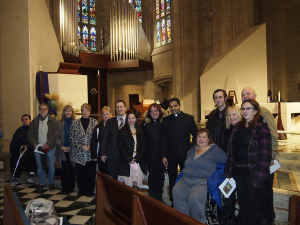 The Elect, Candidates along with their Sponsors who took part in the Rite of Election at the Cathedral of the Most Blessed Sacrament which was presided over by Bishop Arturo Cepeda
The Elect, Candidates along with their Sponsors who took part in the Rite of Election at the Cathedral of the Most Blessed Sacrament which was presided over by Bishop Arturo Cepeda
Elect: Christine Hainley-Peavley.
Candidates: Evan Peavley, Shawn Durrant, Barbara Lefevre, Susan Franz, Cassandra Barnes and Thomas Ryan Alexander.
Sponsors: Joseph and Jennifer Hainley, Jim and Connie Moran, Lisa and Tom Alexander and Suzanne Mote.
Reintroducing the Sanctus Bells at Mass
You are all familiar with Sanctus Bells. Though the bells are still heard in many parishes, many wonder about them. Some long to hear their joyful sounds; and some erroneously believe their use during the Mass is now prohibited.
Since we are a people of senses, sounds are important in our worship, whether in the quiet of the moment, the singing of a congregation, or the sound of the organ. The sound of bells does add to the reverence and the solemnity of the Mass. Most importantly, they highlight in a sensible way the sacred action taking place on the altar. Therefore, we have a tradition that is not only practical but also beautiful.
Sanctus bells have been rung as part of the celebration of the Holy Sacrifice of the mass for over 800 years. Most Sanctus bells are small handheld bells or assemblies of three or five bells that may be rung are directed in Chapter IV, paragraph 150 of the General Introduction of the Roman Missal:
“A little before the consecration, when appropriate, a server rings the bell as a signal to the faithful. According to the local custom, the server also rings the bells as the priest shows the host and then the chalice.”
We have to also keep in mind that the rubrics leave to the discretion of the pastor whether bells should be used or not. Nevertheless, the use of bells at Mass is a longstanding tradition in the Catholic Church and no one should ever think that their use has been suppressed. Actually, the common practice in the basilicas of Rome is for the bell to be rung at each elevation and then in a prolonged way when the priest genuflects after the elevation of the chalice.
Although, at St. Valentine the practical use of the Sanctus Bells has been diminished over time, we are in the process to reintroduce the bells for the weekend masses, as it has been already reintroduced for weekday masses. It can still serve another purpose as an extra aid to call attention at the moment of the elevation especially for those who become out-of-focus and it is an effective catechetical tool for children and adults alike. Altar Servers have been recalled and trained on how to ring the bells during the elevation of the Host and Chalice. A long-standing custom should not just be swept away unless more is to be gained by dropping it than retaining it.
As the 4th Sunday of Lent is called Laetare (Rejoice) Sunday, it’s a liturgically suitable day to reintroduce the bells at St. Valentine. Any quarries or concerns please don’t hesitate to write to me for further clarification at frhenry@stvalentineschool.com
Fr. Henry Rebello SAC

 The miracle of this Sunday links with (and reminds us of) the past two weeks in our liturgy – the Epiphany and the Baptism of the Lord. In Cana, once again, Jesus is “revealed” – all three Sundays are epiphanies of the Lord. John depicts Mary as involved at the beginning of Jesus’ ministry, and at the end he places her at the foot of the cross. Mary is thus associated with the whole ministry of Jesus but her role is always seen in relation to her son. She teaches us that our lives should always be seen in relation to Jesus. Perhaps, on this Second Sunday in Ordinary Time, we could ask ourselves are we, like Mary, involved in revealing Jesus to our world? Or do we find ourselves reserved, embarrassed and maybe even afraid to let others know that we are followers of Jesus?
The miracle of this Sunday links with (and reminds us of) the past two weeks in our liturgy – the Epiphany and the Baptism of the Lord. In Cana, once again, Jesus is “revealed” – all three Sundays are epiphanies of the Lord. John depicts Mary as involved at the beginning of Jesus’ ministry, and at the end he places her at the foot of the cross. Mary is thus associated with the whole ministry of Jesus but her role is always seen in relation to her son. She teaches us that our lives should always be seen in relation to Jesus. Perhaps, on this Second Sunday in Ordinary Time, we could ask ourselves are we, like Mary, involved in revealing Jesus to our world? Or do we find ourselves reserved, embarrassed and maybe even afraid to let others know that we are followers of Jesus?